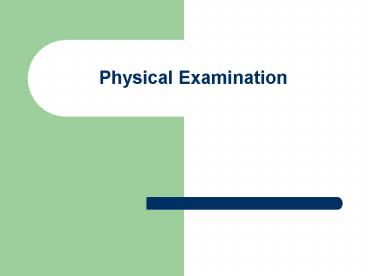Physical Examination - PowerPoint PPT Presentation
1 / 45
Title:
Physical Examination
Description:
The Four Parts of the Chest Exam Inspection Palpation Percussion ... Tenderness Abdominal masses Liver Palpation Special Tests Rebound tenderness Press ... – PowerPoint PPT presentation
Number of Views:70
Avg rating:3.0/5.0
Title: Physical Examination
1
Physical Examination
2
The Four Parts of the Chest Exam
- Inspection
- Palpation
- Percussion
- Auscultation
3
Inspection
- Cyanotic?
- Finger clubbing?
- Caused by certain
- lung disorders
4
Inspection
- How is the patient breathing?
- Rate, Rhythm, Effort
- Any abnormal sounds?
- What muscles are being used?
- Is there any chest deformity or asymmetry?
5
Tracheal Deviation
6
Palpation
- Palpate the ribs and sternum for pain or
deformity - Check for symmetry by palpating lung expansion
7
Palpation
- Tactile fremitus
- Have the patient say ninety-nine while
palpating the base of their lungs - Use the ball of your hand
- Increased vibration indicates increased mucus
production
8
Percussion
- A technique for determining tissue density
9
Percussion
Posterior
Anterior
10
Percussion
- Percussion Notes and Their Meaning
- Flat or Dull Pneumonia (dense)
- Normal Healthy Lung
- Hyperresonant Emphysema (trapped air)
11
(No Transcript)
12
Auscultation - Lungs
- Use the diaphragm of the stethoscope
- Compare one side to the other
13
Auscultation - Lungs
- Abnormal Findings
- Decreased sounds presence of air, as in
emphysema - Crackles sounds like rubbing hair between your
fingers pneumonia - Wheezes such as in asthma
- Rhonchi snoring or gurgling sound
- LISTEN
14
Auscultation - Heart
- Four Main Sites
- Aortic Valve
- Pulmonic Valve
- Tricupsid Valve
- Mitral Valve
15
Auscultation - Heart
16
Auscultation - Heart
- The Heart Sounds
- S1 the tricuspid valve closing
- S2 the aortic valve closing
- LISTEN
17
Physical Exam
18
The Abdominal Exam
- Inspection
- Auscultation
- Percussion
- Palpation
19
The Quadrants of the Abdomen
Right Upper Quadrant
Left Upper Quadrant
Left Lower Quadrant
Right Lower Quadrant
20
Inspection
- Are there any
- Scars
- Rashes/lesions
- Pulsations
- What is the contour?
- Flat/protruding
21
Auscultation
- Use the diaphragm to listen to
- Bowel sounds (increased, decreased, absent?)
- Arterial pulses
22
Percussion
- Percuss for areas of unusual dullness
- This may be a sign of an abdominal mass
- Percuss the area over the liver to check for
enlargement
23
Palpation
- Light and deep palpation of the abdomen
- Check for
- Tenderness
- Abdominal masses
24
Liver Palpation
25
Special Tests
- Rebound tenderness
- Press deeply into the abdomen and release quickly
- A painful response is a sign of peritoneal
inflammation
26
Special Tests
- Shifting Dullness
- Percuss for areas of dullness
- Have the patient roll to one side
- If the dullness shifts this is a sign of excess
fluid
27
Special Tests
- Psoas Sign
- Have patient flex their hip against resistance
- Obturator Sign
- Rotated leg internally at the hip
- Pain in either case denotes appendicitis
28
The Physical Exam
- Neurologic Exam
- Mental Status
- Cranial Nerves
- Motor
- Reflexes
- Sensory
- Special Tests
29
Mental Status
- AVPU
- Alert
- Verbal respond to voice?
- Pain respond to pain?
- Unconscious no response
30
Cranial Nerves
- 12 Cranial Nerves
31
I - Olfactory Nerve
- Not normally tested
32
II - Optic Nerve
- Acuity
- Visual Fields
- Pupillary Reactions
33
III, IV, VI Oculomotor, Trochlear Abducens
Nerve
- Test eye movements
34
V - Trigeminal Nerve
- Three Divisions Test Each For
- Muscle Strength
- Jaw Temple
- Pain Sensation
- Test Corneal Reflex
- Use a cotton wisp
- Normal blinking
35
VII Facial Nerve
- Facial asymmetry?
- Test the following movements
- Raising eyebrows
- Smiling
- Frowning
- Showing your teeth
- Puffing your cheeks
36
VIII Auditory Nerve
- See hearing test notes
37
X Vagus (IX Glossopharyngeal)
- Ask Pt. to Swallow
- Say Ah
- Test Gag Reflex
38
XI Accessory
- Have pt. turn their head
- Have pt. shrug their shoulders
39
XII - Hypoglossal
- Ask pt. to protrude tongue
- Move tongue from side to side
40
Motor Exam
- Check for
- Symmetry
- Atrophy
- Strength
- Tone
41
Dermatomes
- Areas of the skin supplied by nerves from
specific levels of the spinal cord
42
Deep Tendon Reflexes
- Biceps C5,C6
- Triceps C6,C7
- Brachioradialis
- C5, C6
- Abdominal T8-12
- Knee L2-4
- Ankle S1, S2
Diminished reflexes can indicate the presence of
a lesion
43
Babinski Reflex
Indicator of severe central nervous system damage
44
Sensory
- By dermatomes test
- Pain
- Temperature
- Light touch
- Vibration
- Test each side with pts eyes closed
45
Graphesthesia Stereognosis
- Draw a letter or number on the patients palm
- The patient should be able to identify































